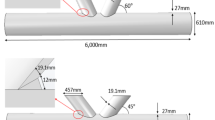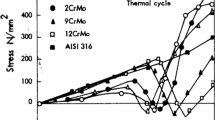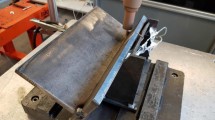Abstract
In order to achieve fatigue resistant welded structures, it is necessary to manage and control welding process-related factors which affect the fatigue strength. These factors are sometimes present as welding defects and sometimes as inevitable residual stresses which are unwanted by-products of welding processes. This subject has been treated in welding research communities since the 1950s. However, the extent of this effect was unclear and is still a matter of debate. Having advanced predictive tools for accurate determining welding residual stresses will not only lead to the possibility of considering precise welding residual stress effects during life estimation but also can be useful to have effective measures for the subsequent mitigation or modification of the welding residual stress fields.
The objective of this study is to describe experimentally and numerically the welding residual stress field in welded tubular joints made of structural steel S355J2H in terms of two different case studies. Residual stresses in cylindrical specimens with dummy welds (case-1) and bead on tube welds (case-2) are determined experimentally by means of x-ray, synchrotron, and neutron diffraction techniques. The SYSWELD software is used to calculate the welding residual stresses numerically by integrating the metallurgical transformation effects in order to compute the link between material microstructure and residual stresses. Thermal and metallurgical calculations couple the temperature field and phase proportions by considering the latent heat of fusion/solidification and the transformations in the transient heat conduction equation. Obtained results which include both thermal and metallurgical history are used as input data for mechanical calculations afterward. The accuracy of the both thermal and structural models is validated through experiments for temperature distribution and residual stresses.











Similar content being viewed by others
References
Kudryavtsev IV (1956) The influence of internal stresses on the fatigue endurance of steel, Int. Conf. on Fatigue. I. Mech. E. p 317
Trufyakov VI (1958) Welded joints and residual stresses, Avt. Sv. No. 5, 1956. Br Weld J 5(11):491–498
Radaj D (1995) Ermüdungsfestigkeit, Fatigue Strength, Springer Verlag. (In German)
Haibach E (2002) Betriebsfestigkeit, Fatigue Strength in Service, 2.Aufl., Springer Verlag. (In German)
Hobbacher A (2007) Recommendations for Fatigue Design of Welded Joints and Components, IIW-Document, XIII-2151-07/XV-1254-07
EN 1993-1-9 (Eurocode 3) (2005) Design of steel structures, Part 1.9: Fatigue strength of steel structures, CEN, Brussels, Belgium
Siljander A, Kurath P, Lawrence FV (1992) Non-proportional fatigue of welded structures, advances in fatigue lifetime predictive techniques, ASTM STP 1122. In: Mitchell MR, Landgraf RW (eds) Philadelphia. p 319–338
Sonsino CM (1999) Overview of the state of the art on multiaxial fatigue of welds, multiaxial fatigue and fracture ESIS publication, vol. 25, p 195–218
Maddox SJ, Sonsino CM (2001) Multiaxial fatigue of welded structures-problems and present solutions. In: Manuel de Freitas (ed) Proceedings of the Sixth International Conference on Biaxial/Multiaxial Fatigue and Fracture, Lisboa, vol. II. pp 3–16.
Bäckström M, Marquis G (2001) A review of multiaxial fatigue of weldments: experimental results, design code and critical plane approaches. J Fatigue Fracture Eng Mater Struct 24:279–291
Farajian M, Nitschke-Pagel T, Siegele D (2014) Welding residual stress behavior in tubular steel joints under multiaxial loading. HTM J Heat Treat Mat 69:6–13
Farajian M, Nitschke-Pagel T, Wimpory Robert C, Hofmann M, Klaus M (2011) Residual stress field measurements in welds by means of x-ray, synchrotron and neutron diffraction. J Mater Sci Eng Technol 42(11):996–1001
Acknowledgments
The paper was supported by the German Research Foundation (Deutsche Forschungsgemeinschaft (DFG)) as part of the project “Numerical description of the behavior of welding residual stress field under multiaxial mechanical loading.” The authors would like to thank the DFG for its support.
Author information
Authors and Affiliations
Corresponding author
Additional information
Recommended for publication by Commission XIII - Fatigue of Welded components and Structures
Rights and permissions
About this article
Cite this article
Hemmesi, K., Farajian, M. & Siegele, D. Numerical and experimental description of the welding residual stress field in tubular joints for fatigue assessment. Weld World 60, 741–748 (2016). https://doi.org/10.1007/s40194-016-0328-6
Received:
Accepted:
Published:
Issue Date:
DOI: https://doi.org/10.1007/s40194-016-0328-6




